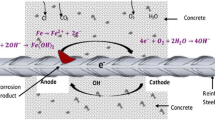Abstract
The premature deterioration of concrete structures due to corrosion of the steel reinforcement is a major problem in the field of civil engineering, particularly when aggressive environmental conditions are encountered.
This paper presents an acute case of widespread corrosion damage observed on a ground slab of a huge prestigious building complex constructed at the southern part of Iraq in the late eighties. The paper describes the remedial measures necessary for extending the service life of the structure.
The test programme comprises detailed visual inspection of the retrieved samples including the condition and the number of protective layers, thickness of cover to reinforcement, description of reinforcement size and distribution, signs and degree of corrotion. The concrete cores were then subjected to different chemical and physical tests.
Chemical and electrochemical survey clearly indicated that the corrosion damage was confined to the top slab reinforcement and that corrosion was induced by internal chloride attack. Chloride ions were introduced into concrete by the initial use of chloride contaminated sand in the concrete mixes and the subsequent application of saline water used for concrete curing. The curing process resulted in distinct increase of chloride concentration in the first 6 cm layer of concrete. Chloride content as high as 0.76% was obtained.
The pattern of chloride distribution encourages a repair technique which looks separately at different layers of concrete in accordance with their degree of contamination. In addition a surveillance network for potential measurements was suggested.
Résumé
La détérioration prématurée de constructions en béton due à la corrosion des armatures est un problème majeur dans le domaine du génie civil, notamment lorsque l'on observe des conditions agressives pour l'environnement.
Cet article présente un cas aigu d'endommagement dû à la corrosion que l'on a pu remarquer sur la dalle plancher d'un immense ensemble de bâtiments de haut prestige au sud de l'Irak à la fin des années 1980. L'article décrit les mesures nécessaires pour prolonger la durée de vie de cette construction.
Le programme d'essais comprend une inspection visuelle détaillée des échantillons prélevés ainsi que les conditions et le nombre de couches de protection, l'épaisseur de la couverture de renforcement, la description de la taille du renforcement et celle de la distribution, les signes et les degrés de corrosion. Les échantillons de béton ont fait l'objet de différents essais physiques et chimiques.
L'étude chimique et électrochimique a clairement montré que les dommages dus à la corrosion se situaient sur la partie supérieure de la dalle et que la corrosion était provoquée par une attaque interne aux ions chlorure. On a introduit des ions chlorure dans le béton, tout d'abord par l'utilisation de sable contaminé aux ions chlorure dans des mélanges de béton, et ensuite par l'application d'eau saline visant à curer le béton. Cette cure a entraîné une nette augmentation du taux de concentration des ions chlorure sur les six premiers cm de la couche de béton. La teneur en ions chlorure a atteint un plafond de 0,76%.
Le modèle de distribution en ions chlorure favorise une technique de réparation qui s'adresse séparément à différentes couches de béton, en fonction de leur degré de contamination. En outre, un réseau de surveillance de mesures éventuelles a été proposé.
Similar content being viewed by others
References
Schiessl, P., Report W1078/6, State Organization for Roads and Bridges, Baghdad, July 1989.
Katwan, M. J., Technical report No. C1/89, National Centre for Construction Laboratories, NCCL, Baghdad, Nov. 1989.
Technical Report No. C2/96, National Centre for Construction Laboratories, NCCL, Baghdad, Jan. 1996.
‘An investigation on the defects of the floor slab’, Technical Report, Consulting Bureau of the College of Engineering, University of Baghdad, Baghdad, July 1997.
American Standards ACI 201-2R, 318, 222R, BS 8110.
Katwan, M. J.,et al., ‘Allowable limits for sulphate in concrete, toward the amendment of IOS No. 45/1984’,Magazine of Engineering and Technology 15 (3) (March 1996) 25–40.
Nustad, G. E.et al., New techniques for concrete repair-mechanisms and advances of chloride extraction and realkalisation’, Proceeding, 5th International Conference on Deterioration and Repair of Reinforced Concrete in Arabian Gulf, Bahrain, Vol. 1, Oct. 1997, 403–412.
Wyatt, B. S., ‘Cathodic protection of steel in concrete—a mature engineering solution—at last’, 2nd Regional Concrete Conference on Concrete Durability in the Arabian Gulf, Bahrain, March 1995, 243–263.
Kendell, K., ‘A five year review of the cathodic protection to various industrial concrete structures in the Arabian Gulf’, 2nd Regional Concrete Conference on Concrete Durability in the Arabian Gulf, Bahrain, March 1995, 265–280.
Matta, G. Z. and Giannetti, F., ‘The use of calcium nitrite admixtures in the Arabian Gulf, 2nd Regional Concrete Conference on Concrete Durability in the Arabian Gulf, Bahrain, March, 1995, 157–171.
Maeder, U., ‘A new class of corrosion inhibitors for concrete’, 2nd Regional Concrete Conference on Concrete Durability in the Arabian Gulf, Bahrain, March 1995, 173–185.
Author information
Authors and Affiliations
Rights and permissions
About this article
Cite this article
Katwan, M.J. Corrosion of steel reinforcement in hot countries, an acute case study. Mat. Struct. 34, 360–366 (2001). https://doi.org/10.1007/BF02486487
Received:
Accepted:
Issue Date:
DOI: https://doi.org/10.1007/BF02486487




